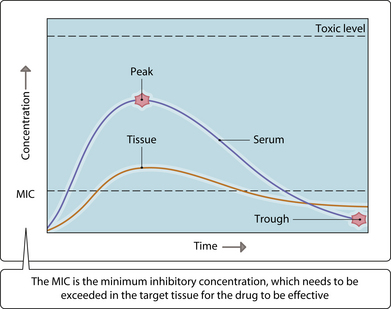41. Antibacterial therapy
practice
Some agents are narrow spectrum and mainly active against a limited range of bacteria (e.g. penicillin activity against Gram-positive bacteria or gentamicin activity against Gram negative). Broad-spectrum agents such as cefuroxime and ciprofloxacin are active against a wide range of bacteria (Fig. 3.41.1). Such agents are clinically useful, but extensive usage is likely to encourage resistance by inducing or selecting resistant strains and allowing gastrointestinal overgrowth with Clostridium difficile.
Dosing regimens
The antibacterial agent must achieve sufficient distribution to reach the site of infection. Factors such as lipid solubility, protein binding, intracellular penetration and the ability to cross the blood–brain barrier affect distribution. In order to eradicate bacteria, the antimicrobial serum level must be kept above the bacterial minimum inhibitory concentration (MIC; Fig. 3.41.2). However some antibiotics possess a postantibiotic effect (PAE), which delays bacterial regrowth even if the plasma antibiotic concentration falls below the MIC. These antibiotics (e.g. gentamicin) can be dosed once daily and are classified as concentration-dependent killing. In contrast, most β-lactam antibiotics do not exhibit any PAE and have to be given more than twice daily.
< div class='tao-gold-member'>
Stay updated, free articles. Join our Telegram channel

Full access? Get Clinical Tree










